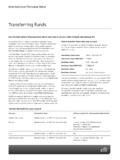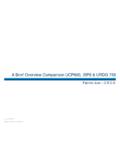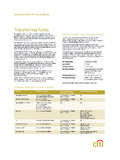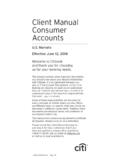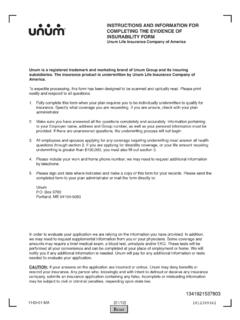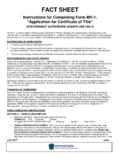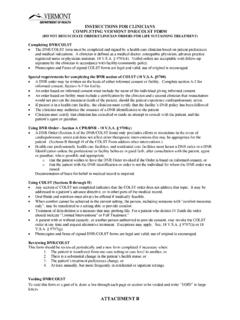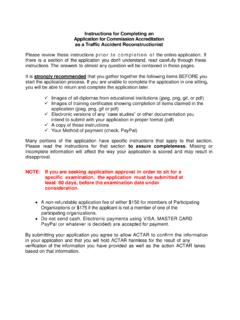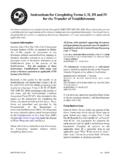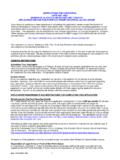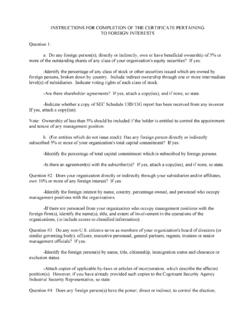Transcription of Simplified Instructions for Completing a Form W-8BEN-E
1 Treasury and Trade SolutionsFor Non-Financial Institutions OnlyUpdated April 2015 Simplified Instructions for Completing a form W-8 BEN-ECircular 230 Disclaimer: Any tax advice contained in this communication is not intended or written by Citigroup to be used, and cannot be used, by a client, or any other person or entity for the purpose of avoiding penalties that may be imposed under the Internal Revenue Code or applicable foreign or local tax law provisions. This communication is of a general nature and based on authorities that are subject to change. It is provided for information purposes only and is not intended and should not be relied upon as a substitute for professional tax guide is intended for use in Completing a form W-8 BEN-E (February 2014 version) to document the foreign status and the FATCA status of a legal entity that is not a Person.
2 For definitions of important terms (indicated in quotes), please see the step-by-step Instructions are targeted to entities that are not Financial Institutions for FATCA purposes and who are opening a bank deposit account or investing in time deposits. This guide only includes Instructions relevant to these particular situations. If you are Completing this form on behalf of a Financial Institution or are opening a custodial account for securities or entering into other transactions, please use the official IRS Instructions Instructions for Completing a form W-8 BEN-EStep 1: Confirm that you are not precluded from using form W-8 BEN-E:Review the situations listed at the top of the form under the header Do NOT use this form if. If any of these situations apply to you, please use the form indicated, instead of form 2: Identify the Beneficial Owner of the Account in Part ILine 1 (Name of Beneficial Owner): Enter the full name of the legal entity that is the Beneficial Owner.
3 The entity name should conform to the name as shown in the formation document, including any amendments. Please do not use any abbreviations other than those commonly used to indicate the type of entity ( , , , etc.).Line 2 (Country of organization): Enter the name of the country in which the legal entity was created, organized, incorporated or governed. Please do not abbreviate the country name. However, if this country is the United States, you ordinarily should not be Completing a form W-8, but should complete IRS form W-9 3 (Disregarded Entity): If you are a disregarded entity but are NOT a financial institution, leave line 3 4 (Entity Classification): See Instructions in Step 5 (FATCA Status): See Instructions in Step 6 (Permanent Residence Address): Enter the Permanent Residence Address of the legal entity.
4 Include the street name or rural route, apartment or suite number, and the country name (please do not abbreviate the country name), but do NOT use: A post office box (unless that is the registered address of the entity); An address at a financial institution; An address used solely for mailing purposes, or An in-care-of address (unless that is the registered address of the entity).The permanent residence address of the entity is the address in the country where the entity claims to be a resident for purposes of that country s income tax. If the entity does not have a tax residence in any country, the permanent residence address is where it maintains its principal 7 (Mailing Address): Enter your mailing address if different from the Permanent Residence Address. Please do not abbreviate the country 8 ( TIN): If you have a taxpayer identification number (TIN), enter it on this line.
5 A TIN is not required to obtain a reduced rate or exemption from withholding on interest paid on a bank deposit account or a time 9a (GIIN): Not applicable. A legal entity is not required to have a GIIN, unless it is a reporting Financial Institution, a trustee of a trustee documented trust, a direct reporting NFFE or a sponsored direct reporting NFFE. Line 9b (Foreign TIN): For a deposit account opened at the office of a bank, you MUST provide the foreign taxpayer identification number issued to you by the country in which you are a tax resident, unless: You have not been issued a foreign TIN, or That country does not issue 10 (Reference numbers): If the entity filing the form W-8 BEN-E is the single owner of a disregarded entity, use line 10 to identify the disregarded entity (by name) and thereby associate the form with an account held by the disregarded and Trade SolutionsStep 3: Determine the Entity TypeMark the one box that applies on line 4.
6 Determine the classification of the legal entity based on tax principles. Below is a description of some of these tax business entity is a per se foreign corporation, if it is a type of entity described in Treasury Regulations section (b)(8) for the country in which the entity is incorporated. If a business entity (other than a per se foreign corporation) has only one owner, it is classified as either a corporation or a disregarded entity. If the single owner does not have limited liability, the entity is disregarded as an entity separate from its owner and the single owner should complete the applicable tax form in its own name. If the single owner does have limited liability, the entity is classified as a business entities that have two or more members are classified as either a corporation or a partnership.
7 If no member of the business entity has unlimited liability for the debts of the entity, the entity has a default classification of a corporation. If any member has unlimited liability, the business entity has a default classification of a partnership. Business entities, other than per se foreign corporations, may elect to be classified in a manner different from their default classification (a disregarded entity, a partnership or a corporation) by filing a check-the-box election on form 8832 with the IRS. If such an election has been made, the elected classification applies (and not the default classification) for purposes of Completing form 4: Determine the FATCA Status of the EntityMark the one box that applies on line 5 and complete the Part of the form associated with that FATCA status.
8 Accordingly, you should not complete any other Parts among Parts IV through first 14 FATCA Statuses listed on line 5 (plus a Part XVII Territory Financial Institution) apply only to Foreign Financial Institutions (FFIs) and thus do not apply to non-financial institutions. The remaining FATCA statuses (Parts XIII through XVI and Parts XVIII through XXVIII) may be broken down into three categories as shown below:To determine whether a particular FATCA status applies in your situation, please read the qualifications for that status as recited in the Part of the form associated with that status. If you need additional information, you should refer to the complete IRS Instructions to form W-8 BEN-E or consult your tax advisor. Category 1: Exempt Beneficial OwnersFATCA StatusComplete PartForeign government, government of a possession or foreign central bank of issueXIIII nternational organizationXIVE xempt retirement planXVEntity wholly owned by exempt beneficial ownersXVI Note: Category 1 FATCA statuses do not apply with respect to obligations ( , bank deposit accounts or time deposits) held by the beneficial owner in connection with the conduct of a commercial financial activity of a type engaged in by an insurance company, custodial institution or a depository institution.
9 5 Simplified Instructions for Completing a form W-8 BEN-ECategory 2: Excepted Non-Financial Foreign Entities (NFFEs)FATCA StatusComplete PartNonfinancial group entityXVIIIE xcepted nonfinancial start-up companyXIXN onfinancial entity in liquidation or bankruptcyXX501(c) organizationXXIN onprofit organizationXXIIP ublicly traded NFFE or NFFE affiliate of a publicly traded corporationXXIIIE xcepted Territory NFFEXXIVA ctive NFFEXXVE xcepted Inter-Affiliate FFIXXVIID irect Reporting NFFEN/ASponsored direct reporting NFFEXXVIII Note: An excepted NFFE is excused from any requirement to make representations about, or to disclose the identity of, its owners or controlling persons to a withholding : An NFFE whose stock is publicly traded on an established securities market or any of its affiliates may claim a FATCA exception by marking the applicable box on line 5 and Completing Part XXIII.
10 For the Parent corporation: Mark box 37a and enter the name of one securities exchange where the stock is regularly traded. For an affiliated corporation: Mark box 37b and enter the name of the Parent corporation whose stock is publicly traded. Category 3: Passive NFFEsFATCA StatusComplete PartPassive NFFE under Treasury RegulationsXXVI (and XXX, if applicable)Passive NFFE under an IGAXXVI (and attach a certification and a list of controlling persons) Note: A passive NFFE must mark the box on line 40a to certify that it is not an excepted NFFE. If the claim is made under the Treasury Regulations, a passive NFFE must either represent on line 40b (by marking the box) that is has no substantial owners, or if the passive NFFE has substantial owners, it must mark box 40c and identify each substantial owner (by name, address and TIN) in Part XXX.


